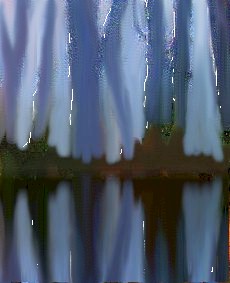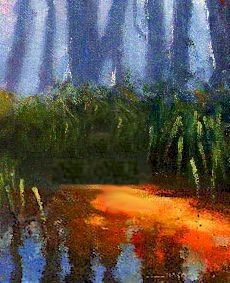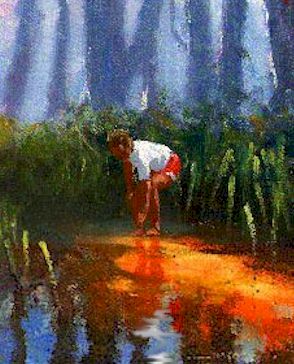5-2 RIVERS, LAKES AND PONDS
Robin wrote:
'I've been studying other works and trying to
achieve something in the way of great depth to water scenes via mulitple
layers of thin paint ... mostly transparent due to being so severely diluted
with Linseed Oil. It's not quite there, so I'm now thinking of using Marine
Varnish, but if that doesn't work, I'll have to trash the whole thing.!)'
Don't despair for this is not necessarily a matter of glazes, although they
may help in certain instances. If you want to paint something behind something
else, you might consider painting exactly that. Depth is achieved in the
logical mind of the observer, assisted by the artist providing all the
necessary information (clues). This is also demonstrated in my lesson on waves.
 |
Clear water has no
color so it cannot be painted. All that can be painted is what is under
it, over it,standing in it, or what is reflected upon its surface. After all those things are painted then the water will magically appear.
Some reflections will prevent the transparency ....
Some will assist ....
Some will describe the nature of the surface...
To achieve great depth in water scenes you
will need to paint in a number of layers simeltaneously.
1. The bottom of the lake or water
2. The reflected sky overhead. A little darker than it is.
3. Reflected vegetation from around the shore
4. Perhaps some lilly pads or something else on the surface. Leave a part
where the viewer can see to the bottom.
|
This 'demonstration painting' provides the
simplest of examples. Construct it yourself as it will only take moments.
 |
Black white and blue will make a subdued background.
The reflection is a value darker than the sky.
|
 |
Wipe away the center portion and introduce
a green bank.
The area where the bank is reflected, will be the area that receals the
bottom of the pond. Why? The angle of the main light source, and the shadows
of the overhanging bank, prevent the sky reflections.
This is where I introduce some color and blend with foreground.
You can also paint in some submerged sticks to detail the bottom, as well
as some drooping reeds. Don't overdo it! The pond bottom can be any color
that suits your purpose - as could the sky. I have used separated opposites.(see
lessons on color)
|
Next, paint in a figure or something
else that will enable you to add aditional reflections and depth. As I
had already used red, yellow, green and blue I used white for the shirt.
You can paint thousands of variations on this theme. No glazes are necessary,
and the basic theory is presented in an earlier lesson on 'sunrise
and sunset'.

GO TO .... golden mean
Main menu
|



